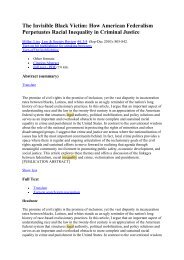Ski – resort and regional development: profile of visitors ... - E-Journal
Ski – resort and regional development: profile of visitors ... - E-Journal
Ski – resort and regional development: profile of visitors ... - E-Journal
Create successful ePaper yourself
Turn your PDF publications into a flip-book with our unique Google optimized e-Paper software.
Tourist characteristics <strong>and</strong> dem<strong>and</strong> for tourism destination products in nigeria, tropical africa<br />
<strong>of</strong> tourists. However, more recent studies, specifically, Parolin (2001) <strong>and</strong> Moscardo (2001)<br />
revealed rather low association between travel patterns <strong>and</strong> some socio-economic characteristics<br />
<strong>of</strong> tourists. Though Parolin identified some common types <strong>of</strong> travel dem<strong>and</strong> patterns in the<br />
structure <strong>of</strong> day trips in New South Wales, but these were specific to some socio-economic<br />
segments only. Similarly, Moscado (2001), revealed no significant differences for overall trip<br />
enjoyment between tourists from within the local region or overseas, or between tourists <strong>of</strong><br />
various ages <strong>and</strong> travel groups on the Great Barrier Reef, Australia.<br />
The second approach posits that tourist’s product choice or dem<strong>and</strong> depends on social, cultural<br />
or national group <strong>of</strong> tourists. The individual tourist’s is believed to be influenced by the social,<br />
cultural or nationality groups they belong. Thus, the collective value, taste, lifestyle <strong>and</strong><br />
characteristics <strong>of</strong> social, national or cultural groups are interpreted as instrumental in moulding<br />
individual tourist’s behaviour <strong>and</strong> taste in some structured manner (Holloway & Plant, 1998).<br />
Earlier studies that investigated product dem<strong>and</strong> <strong>and</strong> preference patterns <strong>of</strong> tourists in the<br />
context <strong>of</strong> social, cultural <strong>and</strong> national groups include Burch (1986), Check (1981), <strong>and</strong> O’<br />
Leary (1981). These studies showed that the social group is the most common unit <strong>of</strong><br />
participation amongst tourists, when individuals are compared to groups; with the family<br />
emerging the most frequent visitor group identified by G<strong>of</strong>fman (1971). Other similar <strong>and</strong><br />
more recent studies such as, Field <strong>and</strong> O’ Leary (2001), showed tourist’s groups as the peer<br />
group, the family group <strong>and</strong> a combination <strong>of</strong> family <strong>and</strong> friends participating in like activities<br />
in areas they visited. Butler (1991), <strong>and</strong> Holloway <strong>and</strong> Plant (1998), suggest that there is a<br />
strong tendency for individuals to conform to the norms <strong>and</strong> values <strong>of</strong> social groups (peers,<br />
students, workmates, friends, neighbours) <strong>and</strong> relations, cultural, national or <strong>regional</strong> groups<br />
in their aggregate patterns <strong>of</strong> dem<strong>and</strong> for tourism products. The assumption that culture,<br />
nationality or social group influences tourist’s behaviour undoubtedly informs a major motive<br />
why the British tourism authority regularly monitors different tourists’ markets from various<br />
countries <strong>and</strong> regions in their tourism product dem<strong>and</strong> (English Tourism Board, 1983; Medlik,<br />
1985).<br />
The third approach explains tourists’ destination product dem<strong>and</strong> <strong>and</strong> participation patterns<br />
as a function <strong>of</strong> available resources; that is destination product supply tends to influence<br />
tourists’ dem<strong>and</strong>. Both supply <strong>and</strong> dem<strong>and</strong> factors in tourism destinations are thus viewed<br />
as integrated <strong>and</strong> constituting a coherent system. There are practical reasons that suggest that<br />
the nature <strong>and</strong> quality <strong>of</strong> environmental resources in tourism destinations influence tourists’<br />
entering the market, as most facilities provided have been used by tourists. However, such<br />
assumptions have been validated in only a few empirical studies such as those <strong>of</strong> Crompton<br />
(1979), Gartner (1986), <strong>and</strong> Afolabi (1993). The variables used as surrogates for assessing<br />
destination environment quality in previous studies include climate, distance, aesthetic pleasing<br />
natural <strong>and</strong> cultural environmental features, facilities, amenities <strong>and</strong> service quality, etc (WTO,<br />
1999; Mills <strong>and</strong> Morrison, 1985). Destination environment quality or pull factors was scored<br />
much less than socio-psychological or push factor as determinant <strong>of</strong> travel dem<strong>and</strong> in previous<br />
studies by Pearce (1982), <strong>and</strong> Dann (1989). The physical components <strong>of</strong> destination environment<br />
Tourism Today - Fall 2007 - Full Paper<br />
81














